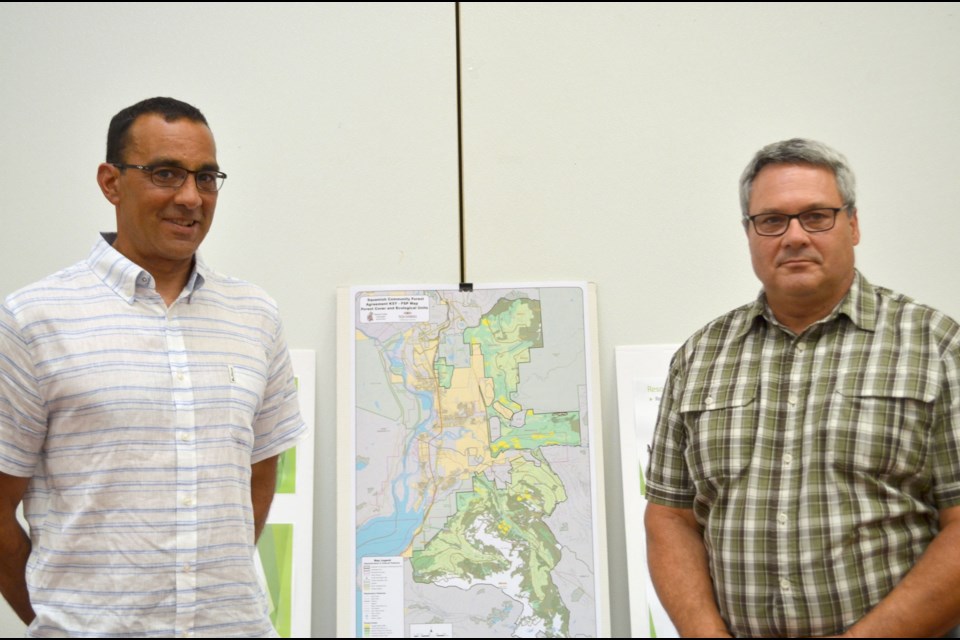Officials are asking locals what they want to see in Squamish's upcoming community forest.
On July 26, officials from Sqomish Forestry and Chartwell Resource Group Ltd. held an open house event to gather feedback on the project. They are gathering comments from the community because they believe a local community forest application before the province is on the verge of being approved.
The services of both companies were enlisted by the Squamish Community Forest Corporation, which is the oversight company of both the Sḵwx̱wú7mesh Úxwumixw (Squamish Nation) and the District of Squamish.
That corporation is managed by a board of directors that will include both members of the municipality and the Nation. If the application succeeds, they will be responsible for the governance of the community forest.
Sqomish Forestry will be managing the forest, and Chartwell is helping with the application, plans and permitting process.
Both the District and the Nation are partners in the endeavour. If the province approves the application, a large swath of land just east of town would come under the governance of the two parties via their joint corporation.
The area would encompass places such as Shannon Creek, Raffuse Creek, Stawamus River, Mashiter Creek, Ring Creek, and areas south of Alice Lake, as well as the lower Mamquam River, among others.
Currently, these areas are governed by the province.
Should local governments be given a chance to create a community forest, it would give the community more of a say over what happens in the area.
This would include greater control of forest stewardship and timber harvest decisions.
There would also be more local consideration of community values, such as recreation, wildlife, watersheds, viewscapes and cultural and spiritual sites.
This is not the first time an open house about the prospective community forest has been held. An application was before the province in 2019, but it was delayed. This is the latest attempt at the project.
Rick Jaccard of Sqomish Forestry said once the licence for the community forest is approved, the next step will be to create a forest stewardship plan, or FSP. That document will also need the green light before operations can start.
"[The] open house here today is getting that ball on the path of getting the FSP approved," said Jaccard. "And then there's going to be a whole lot of stakeholder engagement, First Nations consultation."
Abe Litz, a professional forester with Chartwell, said part of the process of getting an FSP approved is a mandatory 60-day public review and comment period, which is ongoing right now.
"There's a range of forest values that are out there, whether it's soils, water, wildlife, visuals, recreation, and that biodiversity, old growth, cultural heritage, you know, all these different things," said Litz.
"The forest stewardship plan, essentially, identifies those values, the values that we're going to manage for, and it provides results and strategies — a path [for] when we manage for this particular value, what is going to be the outcome or a strategy? What is the procedure, which we're going to use to achieve that specific outcome?"
Some of the feedback so far has concerned recreation, educational areas, archaeological features and sacred sites of the Nation.
There's still some work to go before officials can confirm what kind of tangible benefits will occur as a result of the community forest.
However, Jaccard did say that there will be timber harvesting, as that's what the licence will entail.
"Beyond that, you know, I guess we're all ears, whatever makes sense, whatever reflects community values," he said.
Logging has typically been the purview of BC Timber Sales, which generally assigns cut blocks to logging companies that give the province the best bid.
Litz said that a community forest could change how business is done.
"Now the community is the owner," he said. "The profits from the logging, and the way it gets done — there will be much more input opportunity from the community, like how and where we do this harvesting. And then the advantages, the benefits from that harvesting, i.e. the profit from that, stays in the community. And then that's up to the community forest board to determine how that's spent, whether they spend that on trails or they spend that on education."
People have until Aug. 23 to learn more and provide feedback on what they'd like to see in the community forest at https://squamishcommunityforest.org/




